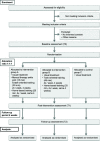Feasibility of a specific task-oriented training versus its combination with manual therapy on balance and mobility in people post stroke at the chronic stage: study protocol for a pilot randomised controlled trial
- PMID: 34311772
- PMCID: PMC8313417
- DOI: 10.1186/s40814-021-00886-0
Feasibility of a specific task-oriented training versus its combination with manual therapy on balance and mobility in people post stroke at the chronic stage: study protocol for a pilot randomised controlled trial
Abstract
Background: Large studies have shown that stroke is among the most relevant causes of acquired adult disability. Walking and balance impairment in stroke survivors often contribute to a restriction in daily activities and social participation. Task-oriented training (TOT) is an effective treatment strategy and manual therapy (MT) is used successfully to enhance ankle joint flexibility in this population. No study, however, has compared TOT against its combination with MT in a randomised controlled trial. Aims of this pilot study are therefore to explore the feasibility of a full-scale RCT using predefined feasibility criteria. Secondary aims are to explore the preliminary effects of specific TOT with a combined specific TOT-MT versus a control group in people post stroke.
Methods: This is a protocol of a 4-week prospective randomised controlled parallel pilot trial in people post stroke at the chronic stage with limited upper ankle joint mobility and an impairment in balance and mobility. At a German outpatient therapy centre using 1:1:1 allocation, 36 patients will be randomised into one of three groups: 15-min talocrural joint MT plus 30-min specific TOT (group A), 45-min specific TOT (group B), and controls (group C). Training will be goal-oriented including tasks that are based on daily activities and increased in difficulty utilising predefined progression criteria based on patients' skill levels. Interventions will be provided face-to-face 2 times per week, for 4 weeks, in addition to 20-min concurrent x4 weekly home-based training sessions. Data will be collected by blinded assessors at baseline, post-intervention and 4-week follow-up. The primary outcome will be feasibility assessed by recruitment, retention and adherence rates, compliance, adverse events, falls and the acceptability of the intervention. Secondary outcomes will be walking speed, single and dual tasking functional mobility, ankle range of motion, disability and health-related quality of life.
Discussion: Feasibility provided, results from this study will be used to calculate the sample size of a larger randomised controlled trial to investigate the effects of specific TOT and specific TOT-MT compared to a post stroke control group.
Trial registration: German Clinical Trials Register, DRKS00023068. Registered on 21.09.2020, https://www.drks.de/drks_web/navigate.do?navigationId=trial.HTML&TRIAL_ID=DRKS00023068 .
Keywords: Ankle joint; Manual therapy; Mobility limitation; Neurological physiotherapy; Postural balance; Range of motion; Stroke; Task-oriented training; Walking.
© 2021. The Author(s).
Conflict of interest statement
The authors declare no competing interests.
Figures
References
Grants and funding
LinkOut - more resources
Full Text Sources
Medical



